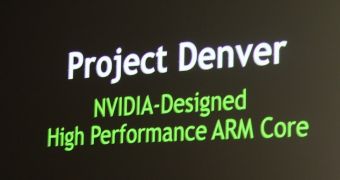Without a doubt, the most important surprise NVIDIA had in store for CES 2011 was its official announcement of “Project Denver”, the company's own graphics-enabled MPU (micro-processor unit), designed to take on the industry leaders (Intel and AMD) in this segment, and it seems that the company will certainly have a winner on its hands, if it manages to overcome both technical obstacles and increased competition. So, within their latest market report, iSuppli provides some pretty interesting predictions as to where the graphics-capable MPU segment is heading, including here the very important role NVIDIA might ultimately play on the market.
“NVIDIA’s entry into the microprocessor segment makes sense, despite the current market dominance of Intel and AMD,” said Matthew Wilkins, principal analyst for compute platforms at IHS.
“In notebook PCs alone, IHS iSuppli research forecasts the penetration rate for graphics-enabled MPUs will increase to 82.9 percent by 2014, up from 39 percent in 2010. This presents an opening for NVIDIA to make inroads into the MPU market,” the analyst added.
The main problem NVIDIA will face (beside increased competition from both AMD and Intel, who'll feel compelled to speed up R&D efforts, due to the appearance of a new player on the market) is related to software, given the fact that very few developers create ARM-supported software programs, most of them being x86-oriented.
Last, but certainly not least, it's interesting to note that IHS's report indicates the fact that NVIDIA is likely to attain success with Project Denver in tablets and low-end notebooks, the exact same target segment of AMD's Fusion APUs and, to some extent, Intel's Atom CPUs (although, to be perfectly honest, it's highly unlikely that the Project Denver MPUs will target tablets, given the fact that the Tegra platform is already doing a fine job in the respective segment).

 14 DAY TRIAL //
14 DAY TRIAL //